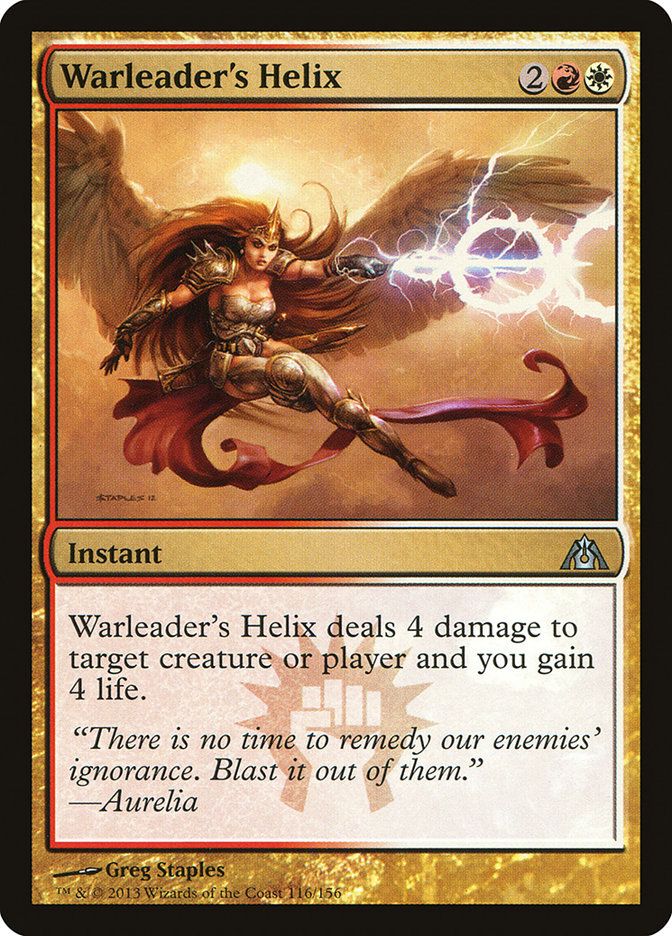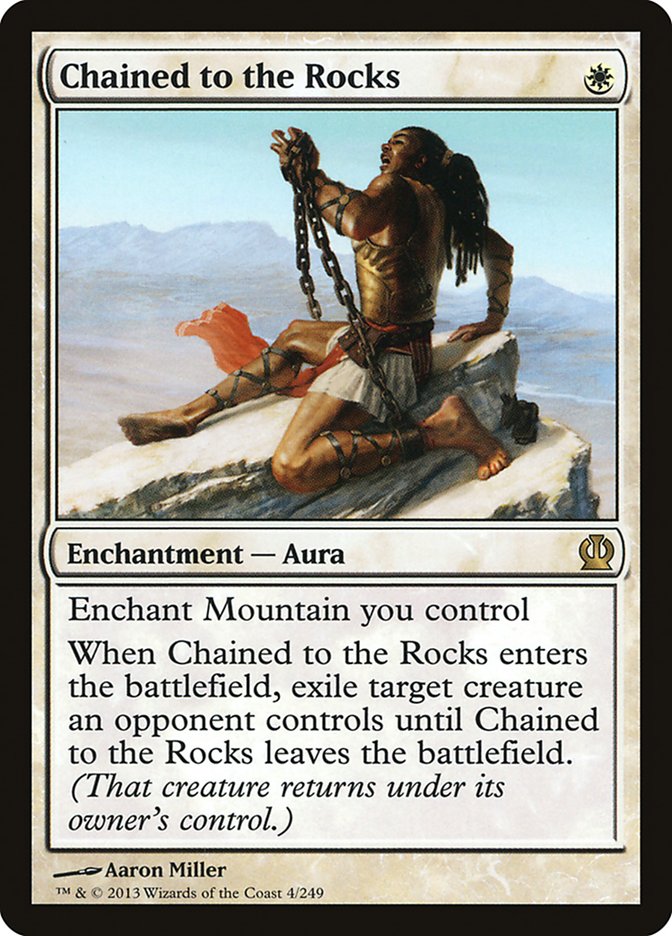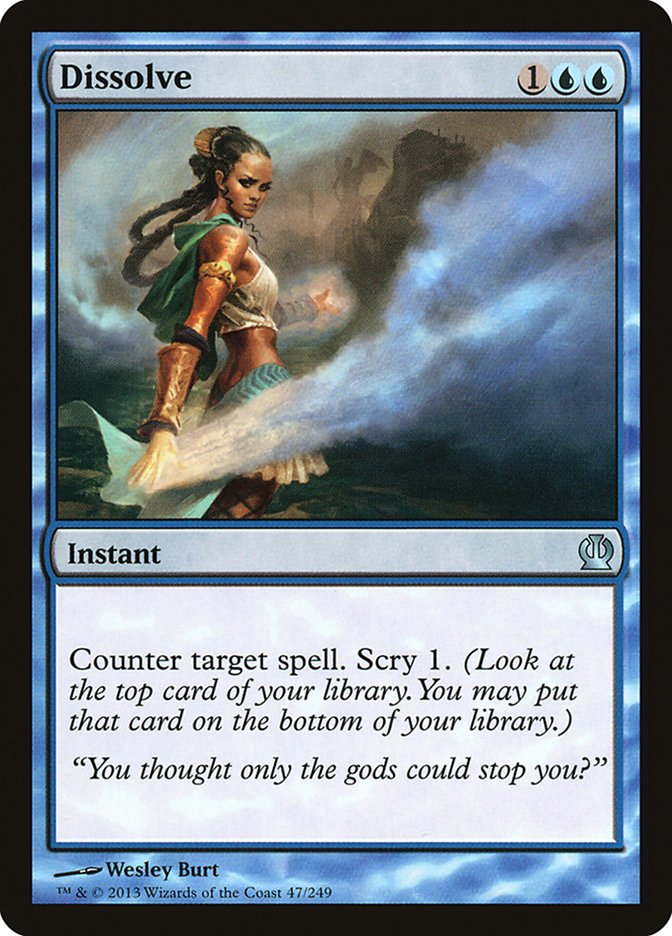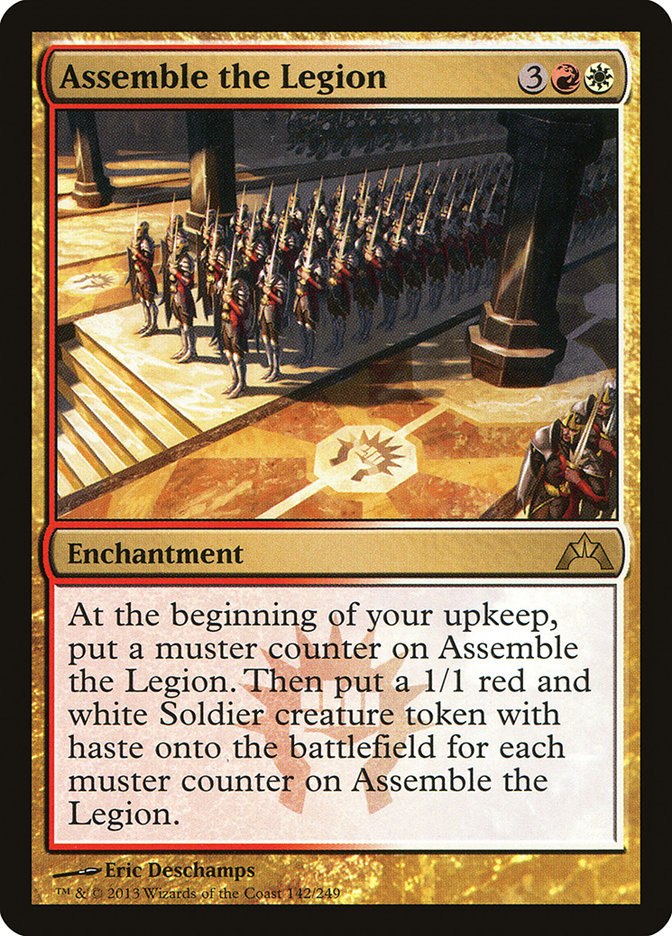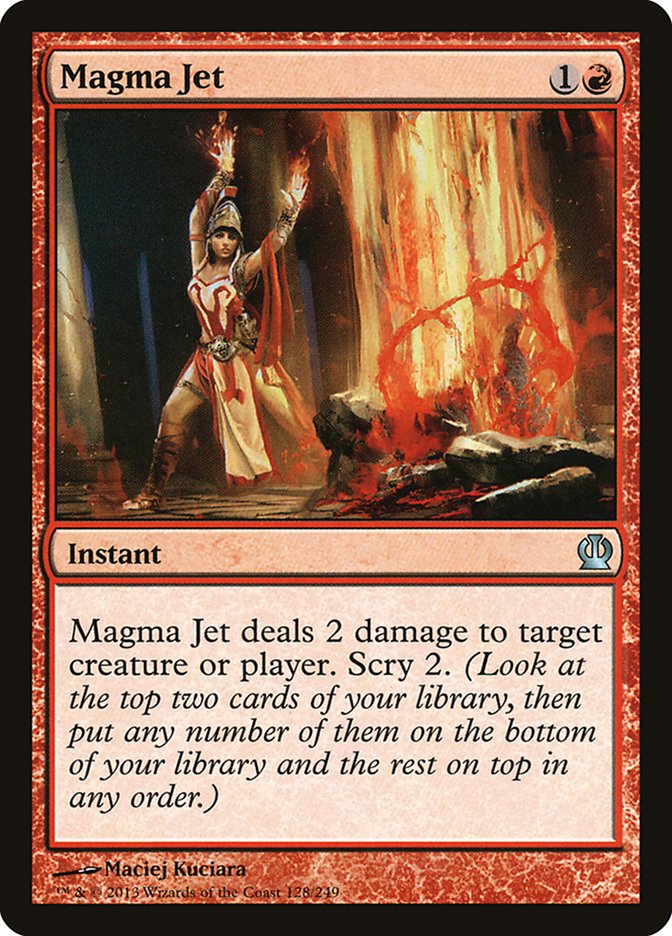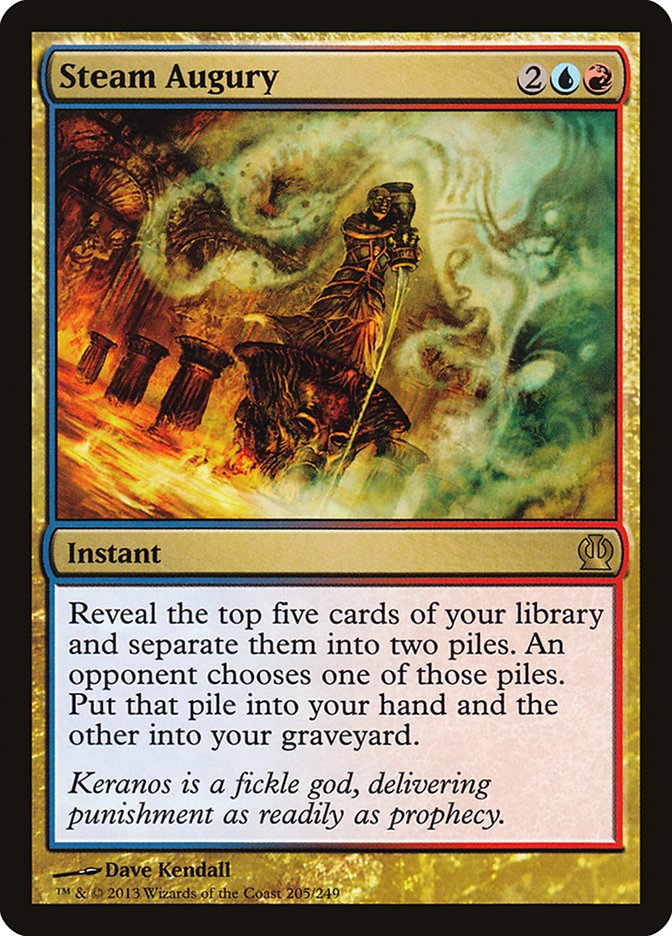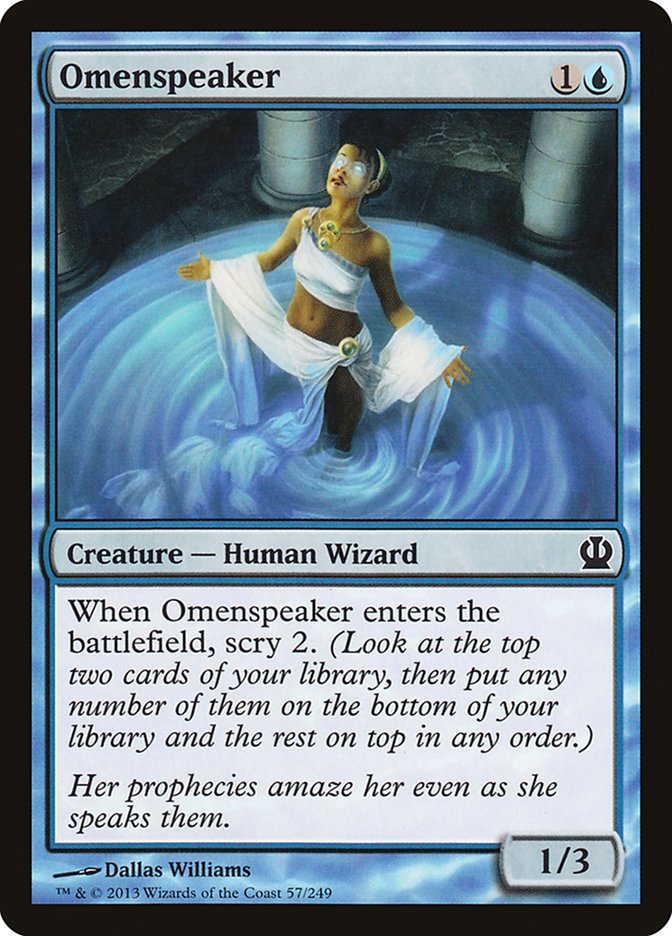After serious consideration, I’ve landed solidly in the U/W/R camp. U/W has all the tools needed for success against the control mirror. However, adding red gives such a great game against midrange and aggro alike. I’ve been grinding away at the U/W/R deck and have a finished product that I’m proud to share. I gave Twitter followers and those who like the "Shaheen Soorani" Facebook page a sneak peek at the control powerhouse that I will be battling with this season with at least for the time being.
The mana was a scary situation, but it turns out that a few tap lands here and there and some damage dealt to yourself isn’t enough to shy away from the third color. It has been working quite well. Today we’re going to discuss the reasons for the switch from U/W to U/W/R, the reasons for the final card choices in U/W/R, and of course the unveiling of the finished product.
But I Want To Play Two Colors!
U/W Control was pretty cool. The mana base was great. The Mutavaults were neat, and it ran very smoothly. The big issue was the power level is pretty weak. Besides a few planeswalkers, we have no real scary cards for the control mirror. With cards like Hero’s Downfall floating around, we cannot depend on planeswalkers alone to carry the control workload and have to find a partner in crime for Aetherling.
Red gives us that answer in the form of Assemble the Legion, which makes any control mage on the other side of the table cringe. Assemble the Legion is a card that is impossible to beat if left unchecked, and with people in love with Heliod, God of the Sun, it makes players packing the red enchantment chuckle at the power difference. One cannot compare the Heliod, God of the Sun to Assemble the Legion and keep a straight face. Heliod requires a heavy mana investment each turn. Assemble gets out of hand in such a short time.
In our previous Standard format, the only time U/W/R defeated my baby Esper is when it stuck that enchantment or an Aetherling, and it’s time for us to take advantage of that combination. Assemble the Legion is also powerful against midrange decks. Decks with efficient creatures at three-plus mana can be outclassed by some hasted Soldiers combined with a little control ingenuity any day.
When only playing blue and white, we’re all in on the "I hope the only time I need to kill something is during the attack step." The U/W list leans heavily on the power of Azorius Charm and Celestial Flare. Cards like Obzedat, Ghost Council and Voice of Resurgence really hurt that strategy, and I have a feeling we will be seeing a decent amount of each of those cards. There are other problem creatures that dodge that type of removal, and it is just too dangerous to depend on those answers as the bulk of your removal package.
Warleader’s Helix provides great spot removal and a life surge. Also, the fact that you can nail an annoying Mutavault at will or a Voice of Resurgence on your turn gives you a bit more freedom than the previous spells discussed. The life gain is still the most attractive part of the spell. Warleader’s Helix has definitely impressed me, and I’m sure most of you all have been big fans for a much longer time. Gaining four life in the early turns is huge and fully complements a Sphinx’s Revelation a few turns later. With a slower, newer format comes a time where just a removal spell or two with some life gain is enough for survival.
The other removal spell involved in this red revolution is Turn // Burn. The split card provides us an out to Obzedat that is much more efficient than any other option in our colors. The big trick to Turn // Burn is not to be tempted into using it early. It’s sometimes an attractive option to use the cheaper removal spell, but remember that if they land the Ghost Council on a board that has little-to-no defense against it, you are dead to rights.
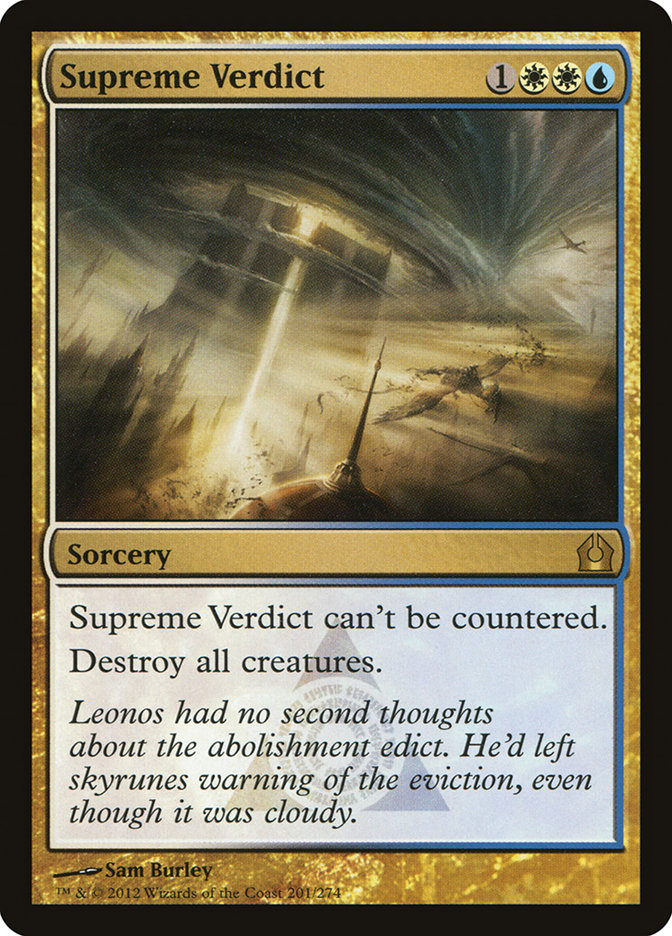 |
vs. |
 |
Supreme Verdict is good, but Supreme Verdict and Anger of the Gods combined is even better. Having the ability to sweep the board on the third turn and then the fourth turn creates a nightmare scenario for decks running mana dorks or any aggressive strategy. Right now I’m battling with a two/two split, and when the format leans one way or the other, those numbers will be altered to adapt. Anger of the Gods has clear advantages over Supreme Verdict when battling against most green and/or white decks. The combination of sweepers is only slightly controversial due to the mana stretch. In a few occasions where I struggled, I was saved by Prophetic Prism. That card, as well as the strength of the mana base, has pushed me over the U/W hurdle into U/W/R.
I’ve always been an advocate of two colors as long as all the answers are in them. In this Standard, U/W and U/B simply don’t have the tools to be fully competitive . . . at least not yet. I begrudgingly ran into the arms of the three-color club, and after some playing I couldn’t be happier. The addition of some life gain and new removal, the stability of the mana base, and the access to a superb win condition against midrange and control sends us into the next segment.
Card Choices
The list from the last article was the pilot and had no testing under its belt. After some trial and error with the deck, I had to shave off a couple cards that didn’t fit and add a few that did. The numbers are still not perfect, but the cards in this 75 have important roles to pave some success in current Standard.
Staying on the Team
This card was as good as I thought it would be. With the absence of Acidic Slime, Chained to the Rocks has become the premier removal spell that handles nearly all threats that approach the red zone in the early game. When playing some matches against G/W and R/G (Brad Nelson Monsters), the Sword to Plowshares lookalike handled big problems for the low cost of one mana. The obvious negative of Chained to the Rocks is that it is sorcery speed, so sometimes a hasted monster will connect prior to its demise.
The serious lack of good enchantment removal (Acidic Slime, Ray of Revelation) gives an open window to the enchantment removal world once again. There is still Abrupt Decay and Destructive Revelry, but there aren’t cards that just blow you out. I don’t mind getting one-for-oned when our opponents are retrieving early-game threats. This is why Journey to Nowhere and Oblivion Ring were powerful in their day against early threats especially (go ahead and take back your mana dork from the early turns and see how that plays out). It’s just a safe feeling when used early and a relief to draw later when facing down a monstrous threat while you are assembling a legion, planeswalkers, and an Aetherling to complete the day.
This is the mana-fixing gem of the deck. The initial list had two, then I got scared and put in three, but now we’re back to two. Testing and fishing are ways to determine optimal mana, and this card is an option to those who want a little insurance with their debut in new Standard. I’m never upset about a card that cantrips and does something, and that’s what Prophetic Prism does. Two turns out to be the number that perfectly fits this build of U/W/R and has on multiple occasions allowed a tough few turns of mana starting with Anger of the Gods early and finishing with a Supreme Verdict.
I had a Trading Post in the first sideboard of U/W/R, but it seems that aggro is just not fast enough to warrant the life stick at this current juncture. The interaction between Prophetic Prism and Trading Post is cute but ultimately unnecessary. If you like to gamble and want to cut these gems, I completely understand. The times where it fixes mana are far and few between; however, you’ll really hurt in those games where your lands don’t cooperate.
Dissolve will be the premier counterspell in Standard. Dissipate was good enough in its day and saw play across the board. Sometimes you were able to Dissipate an Unburial Rites or a random card with flashback, but with Dissolve you get to scry one every time. The move to a counterspell that yields advantage in all matchups is just too good to pass up.
There were other options like Counterflux and Syncopate, but Counterflux is another narrow card that is good against one type of deck and Syncopate is just unacceptable. When Syncopate was released, I’ll admit I was excited, but in 90% of the situations I’d rather just pay one more mana for a hard counter that scrys. Counterflux is a good one against control decks and has been added to the sideboard to complement the Dissolve plan from the maindeck. The original Dissolve count was two, and it has been upped to three due to the slowing down of the format and the shear amount of aggro hate in the maindeck to give us some more gas against control/midrange matchups in game 1.
I raved at the beginning of this article about how good Assemble the Legion is, and now I have to fight the urge to continue praising the enchantment powerhouse. Both of these cards will have homes in U/W/R for the entire season, and you can add me as a new member to the Warleader’s Helix fan club. I always looked past red options because of my Esper obsession earlier, but now that we are Mountain people, it’s time to accept the fact that removal with a huge life bonus attached is just wonderful.
Warleader’s Helix isn’t bad against any matchup because when you’re facing down a control mage, it can give you that reach to finish your opponent after a few Elspeth, Sun’s Champion Soldiers beat or can kill a planeswalker like Jace, Memory Adept after a mill of ten. Both these cards are phenomenal, and I have upped the original Warleader’s Helix count from two to three.
I mentioned in the previous article the strengths of this amazing card. I was wrong; it is a hundred times better than I described in our last discussion. Six mana is a fair and perfect cost for the abilities of the new Elspeth, and I wouldn’t change a thing about it. It flies in and destroys a Blood Baron of Vizkopa, creates an army to stop any ground assault, provides an army to march against the control mirror, or ultimates to do horrible things to any foe after your legion assembles. I haven’t been this excited about a card being printed since Jace, Architect of Thought. Elspeth, Sun’s Champion is the real deal my friends, and get ready to be very impressed by its play.
There are many other cards that are staying in the original list that need no explanation like Aetherling; Sphinx’s Revelation; Jace, Architect of Thought; Azorius Charm; and Detention Sphere. The cards that are sticking around are just control staples that won’t be going anywhere. I invite you all to tweak the list to adapt to your local metagame, which may involve shaving off one or two copies of any of the staples; however, I doubt you would want to drop any completely. Next up are some cards that did not make the cut.
Drop ‘Em!
This card is just worse than Warleader’s Helix, Chained to the Rocks, and Azorius Charm. Some have dropped to two Chains or dropped an Azorius Charm to accommodate a few Magma Jets, but I think that is a mistake. This is a perfect example of a card that may be a bit too narrow in a control deck but because of scry some may jam it in there. I initially thought it would be decent against more than just super aggressive decks, and it turns out that is only good against those decks. The eight turn 1 and 2 removal spells are plenty to set up sweeper city since we go up to seven sweepers after board. Magma Jet is cute but a bit too cute.
I didn’t really like this card to begin with and decided to try one to see if it had a decent game impact. When it was drawn and used early, it was ok, but later in the game it was even worse than I thought it would be. It turns out I’d rather just slam a Jace, Architect of Thought 99 percent of the time, which is why I upped the planeswalker count from two to three. Whenever a spell puts the decision-making in the hands of your opponent, that particular spell loses a lot of power. Maybe if Snapcaster Mage were legal it would regain some of its allure, but in its current state I don’t think it deserves a spot in your 75. If you ever have an urge to Steam Augury someone, I suggest adding a third and then fourth Jace, Architect of Thought, drawing a couple cards, and Fogging for a turn. You’ll feel a lot better.
I couldn’t complete this article without giving a second official public service announcement against playing the dreadful Omenspeaker. If you follow me on Twitter, you know how I feel about this guy. Luckily it’s not the Preordain fight, but the minute Omenspeaker was spoiled, I was disgusted. If you’re an avid control mage like me, you yearn for a card as simple as Wall of Omens or even a reprint of Augur of Bolas. Omenspeaker is a virtual mulligan.
There are some critics of this opinion that argue that each scry is a "half card." That couldn’t be further from the truth. Scry is a sweet ability that helps flush garbage to the bottom and keep gems on the top, but it is not card draw and never will be. It’s just better to play Prophetic Prism, Quicken, Inaction Injunction, or any cantrip in the early turns to hit land drops then playing a worthless 1/3 that may or may not smooth out draws. Not only does this steal a card out of your hand and give you a creature that is only decent against a hand full of matchups, but it also provides opportunities to make huge errors.
You’re on the play and drop an Omenspeaker, and you’ve seen a Sacred Foundry from your opponent. On top you see a land and a Supreme Verdict. What do you do? Do you assume they are control and scry the Supreme Verdict it to the bottom? Then you see a Mountain come and an Ash Zealot crash in. With Preordain you were able to replace the card drawn—that is what made it great—but with this dork you are literally removing a card from your hand to potentially smooth out draws that probably don’t need too much smoothing. Stick with the cantrips and the free scry that comes with just playing lands and countering spells and drop this Omenspeaker for good. Trust me.
The Sideboard
The sideboard of this U/W/R deck is pretty similar to those from the Standard of old. As you all may have guessed, Jace, Memory Adept is the powerhouse of the control mirror. I tried some cute new cards and other strategies to beat our control mirror foes, but it all boils down to the Jace that mills them all. You can still win through Aetherling; Assemble the Legion; and Elspeth, Sun’s Champion, but Jace, Memory Adept is simply better. For that reason I upped his count from two to three in the board.
Against the control mirror you also bring in the counterspell package of Negate and Counterflux and the Glare of Heresy. Glare of Heresy serves as a Disenchant effect against Detention Sphere, Assemble the Legion, and other threatening enchantments that you may face. It also hits Heliod, God of the Sun if anyone is packing that heat for control. The big reason I’ll never play that guy in U/W/R is because he is just way worse than Assemble the Legion. The two Glare of Heresys can also come in against any deck running white permanents that give you an issue like Voice of Resurgence. The two Turn // Burn are cards that protect us against Obzedat, Ghost Council and can also be used to zap any early creatures that give you an issue.
Lastly, the two Supreme Verdicts and one Anger of the Gods are used to solidify your matchup against aggressive decks.
As always, I appreciate all of you, and I try to make that apparent by responding to all the comments at the bottom of the article. I know some of you reading love Omenspeaker and have told me you want to Esper all day every day, and I can’t fault you for it. The beauty of Magic is that you can play Esper, play my U/W/R, or brew up some control deck that is just wacky and have a chance to achieve success regardless. You can’t be on the wrong track when playing the powerful Azorius guild cards that stuck around, and I support all forms of control in this new era.
For those big on Omenspeaker, I implore you to try without it, and I guarantee you’ll be happy with the results. It is one of those cards that just doesn’t have enough upside to be competitive, and that reality will stick until the format is dominated by Grizzly Bears aggro decks. I hope you all enjoyed this article, and I hope I gave you some insight into why I chose the cards I did for U/W/R. Sleeve up my friends and get to work. Let’s show some aggro opponents the "icy grip" of control once again in case they forgot.
-Shaheen
@shaheenmtg – Twitter
[email protected] – Email
Creatures (2)
Planeswalkers (5)
Lands (26)
Spells (27)
- 2 Prophetic Prism
- 4 Azorius Charm
- 2 Supreme Verdict
- 2 Detention Sphere
- 3 Sphinx's Revelation
- 2 Assemble the Legion
- 3 Warleader's Helix
- 4 Chained to the Rocks
- 3 Dissolve
- 2 Anger of the Gods
Sideboard


